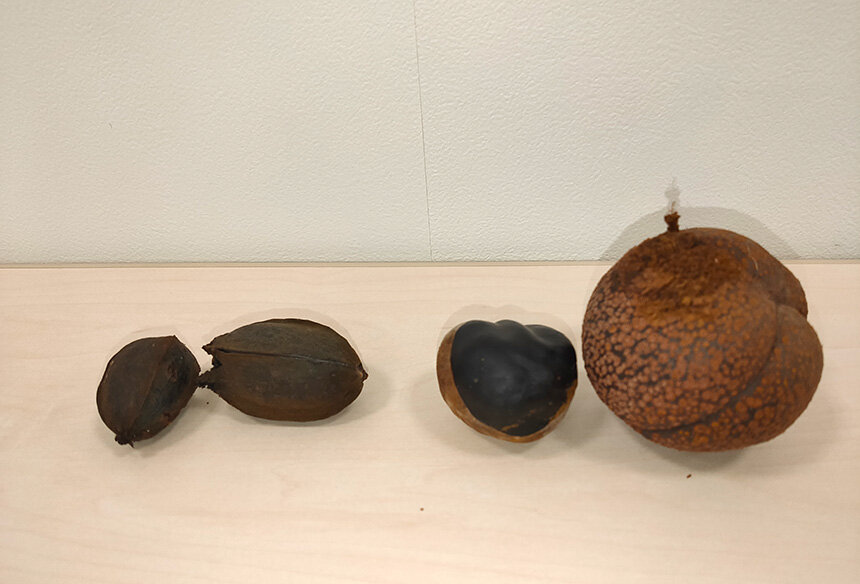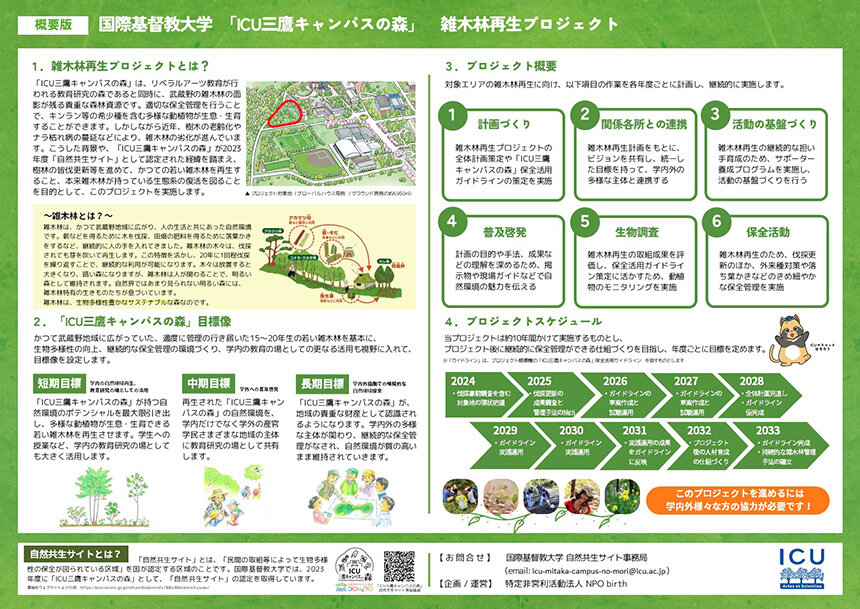NEWS
Learning How to Nurture the Forest Event Held as Part of the Coppice Forest Restoration Project
Update: October 18, 2024

On Saturday, October 5th, an event called Learning How to Nurture the Forest Event was held as part of the Coppice forest restoration project that started this year.
This event was the third in a series of five events aimed at training supporters to work together on the Coppice Forest Restoration Project, and approximately 10 students and alumni participated.
The ICU Campus is a Treasure Trove
At the beginning of the event, Takashi Nakajima, ICU's Managing Trustee for Financial Affairs, introduced the fact that the campus is home to a hidden treasure of pecans and Japanese horse chestnuts for picking. He sent a message to the participants, saying, "There are many treasures hidden in the nature of this campus. I hope you will explore them with curiosity and enjoyment, wondering what kind of treasures you will uncover."

Pecans (left) and Japanese horse chestnuts that grow naturally on campus
A Coppice Forest Managed by People
In the first half of the lecture, a staff member of the NPO birth, a non-profit organization that is helping to promote the Coppice forest restoration project, gave a lecture entitled "What are Coppice Forests?". The plant succession process from grassland to a forest of shade-intolerant trees and then to a forest of shade-tolerant trees over time was presented. Then, there was an explanation that this is a coppice forest where people are involved in conservation by cutting down trees before the forest becomes a forest of shade-tolerant trees over a period of about 30 years, resetting the plant succession process.
In the first half of the lecture, a staff member of the NPO birth, a non-profit organization that is helping to promote the Coppice forest restoration project, gave a lecture entitled "What are Coppice Forests?". The plant succession process from grassland to a forest of shade-intolerant trees and then to a forest of shade-tolerant trees over time was presented. Then, there was an explanation that this is a coppice forest where people are involved in conservation by cutting down trees before the forest becomes a forest of shade-tolerant trees over a period of about 30 years, resetting the plant succession process.
Eradicating Invasive Species to Maintain Biodiversity
In the second half of the event, the participants pulled out non-native species such as broomsedge bluestem, tall goldenrod and giant ragweed at the location of the Coppice Forest Restoration Project. Removing invasive species that flower and produce seeds at this time of year before the seeds are sown, helps to control their spread in subsequent years. The participants pulled out two 90-liter bags of invasive species while exploring the forest in the light rain.
Students and alumni who took part in the event gave comments such as, "By listening to the lecture and working on-site, I was able to see the campus from a different perspective than before" and "I was a student 20 years ago, and I was just interested in seeing how the nature on campus, which was just a landscape, would change. Now, I want to see how this coppice forest will change in the future."

What is the Coppice Forest Restoration Project?
While serving as a forest for education and research where liberal arts education is conducted, the ICU campus is also a valuable forest resource that retains the appearance of the coppice forests in Musashino. It is also home to a diverse range of flora and fauna, including rare species such as the golden orchid. In recent years, however, deterioration of the woodland has progressed due to the aging of the trees and spread of oak wilt disease.
In response to this situation, we are aiming to restore young coppice forests by promoting renewal through clear-cutting, and to revive the original ecosystem of the coppice forests. We also aim to pass on to the next generation the ICU Mitaka Campus Woodland, which was certified as a nature-friendly site by the Ministry of the Environment in 2023.

